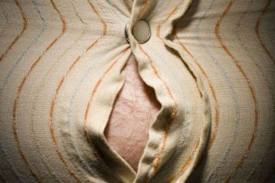Belly fat is a growing health concern, especially as one enters middle age. Muscle mass is lost as one ages and estrogen loss in menopausal women increases the risk of belly fat. Excess stomach fat is tied to a higher risk of diabetes, heart disease and cancer.  As we age, belly fat causes more health problems and also becomes more difficult to eliminate. To battle the belly bulge, it’s important to understand how the body forms and stores visceral fat and subcutaneous fat, the two main forms of abdominal fat.
As we age, belly fat causes more health problems and also becomes more difficult to eliminate. To battle the belly bulge, it’s important to understand how the body forms and stores visceral fat and subcutaneous fat, the two main forms of abdominal fat.
Storing Subcutaneous Belly Fat
Subcutaneous fat forms just beneath the epidermis, the outermost skin layer. This is the visible and loose stomach fat that can be easily pinched around the waistline. This is the type of belly fat that hangs in folds along the abdomen. Subcutaneous fat is most often seen on pear-shaped bodies.
While subcutaneous fat is unattractive, it offers certain health benefits. It releases leptin, a hormone regulating appetite and metabolism and offers the body a protective cushion against trauma. Excess subcutaneous fat can lead to elevated hormone levels that interfere with the functioning of the body’s organ systems.
Storing Visceral Belly Fat
Visceral fat is hidden, growing deep within the abdomen and surrounding vital body organs like the liver and heart. It is most often associated with an apple-shaped body and often causes a protruding belly, sometimes referred to as a pot belly. Visceral fat is considered to be far more dangerous than subcutaneous fat.
Visceal fat causes inflammation by producing proteins known as cytokines. Visceral fat can elevate cholesterol, blood pressure and insulin levels. Visceral fat also raises the risk of colon cancer, asthma and dementia.
Diet Tips
Losing belly fat is no different than trying to lose weight in any other area of your body. Eat a well-balanced diet with an emphasis on complex carbohydrates, unsaturated fats, high fiber and lean proteins. Cut out the heavily processed snack foods that are loaded with fat and sugar, providing your body with nothing but empty calories. Consider eliminating soda (both regular and diet varieties). A study at the San Antonio Longitudinal Study of Aging found diet soda drinkers experienced a 70 percent greater increases in waist circumference. Many people mistakenly think by switching to diet soda, they will help their bodies lose weight. In fact, some people may be tempted to eat more when drinking diet sodas.
Ramp up on proteins when adding weight training to a belly blasting regimen in order to maintain newly formed muscle mass. Avoid extreme diets, as they can trigger the body into starvation mode, leading to abdominal fat retention.
Exercise Tips
Subcutaneous belly fat is stubborn to eliminate, but reducing visceral fat should be your primary fitness goal. Fortunately, visceral belly fat is shed first when it comes to losing weight, according to Dr. Sheila Dugan of Rush University Medical Center.
Forget a stomach crunch marathon. While crunches will strengthen abdominal muscles, these exercises won’t decrease visceral fat. Try strength training with weights combined with cardiovascular exercise, such as walking or cycling. An active lifestyle is key to overall weight loss, including reducing belly fat.




Comments are closed.